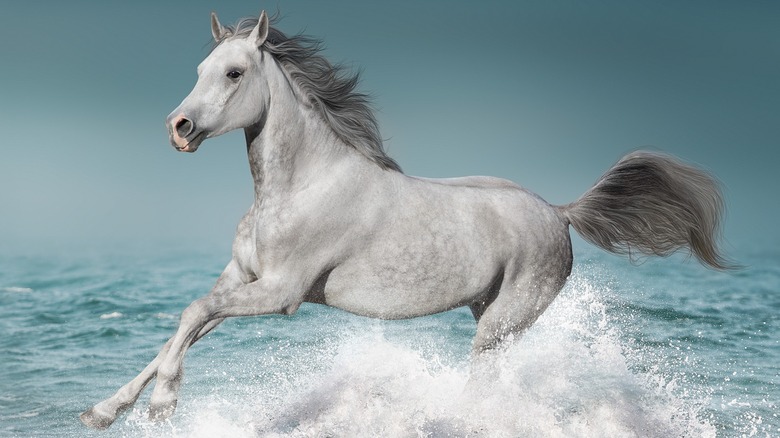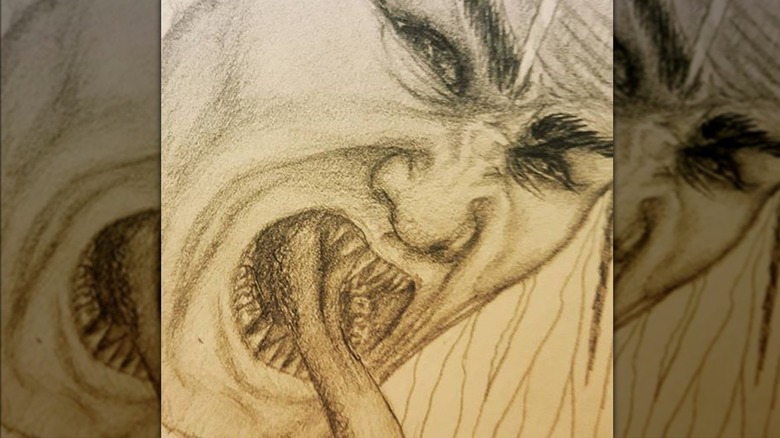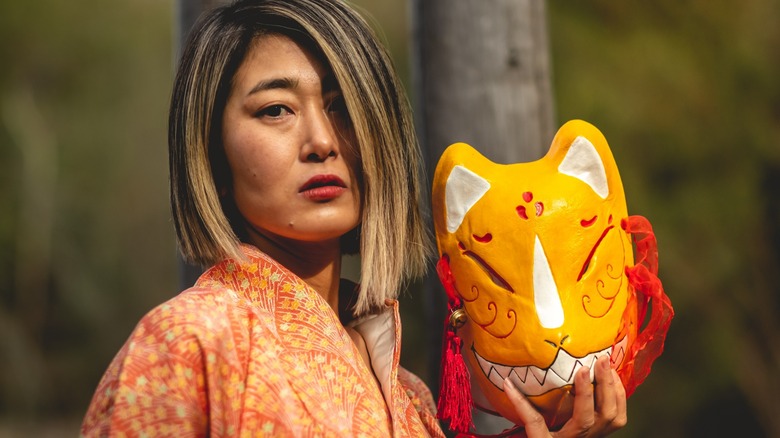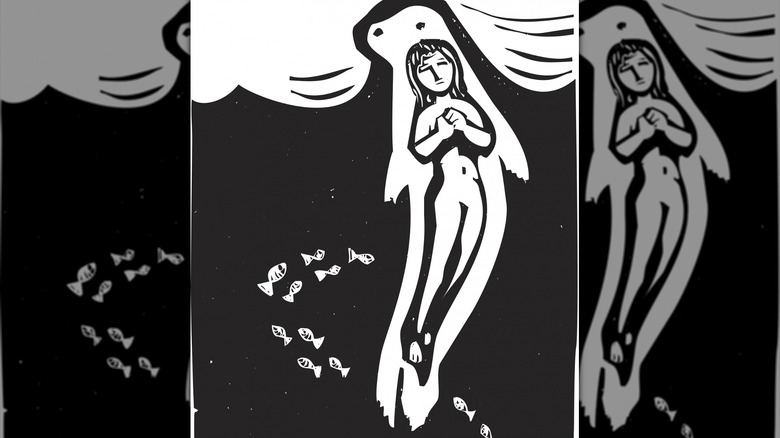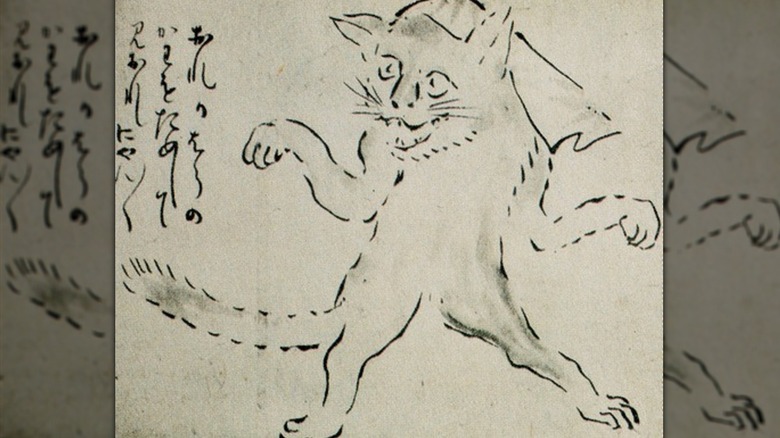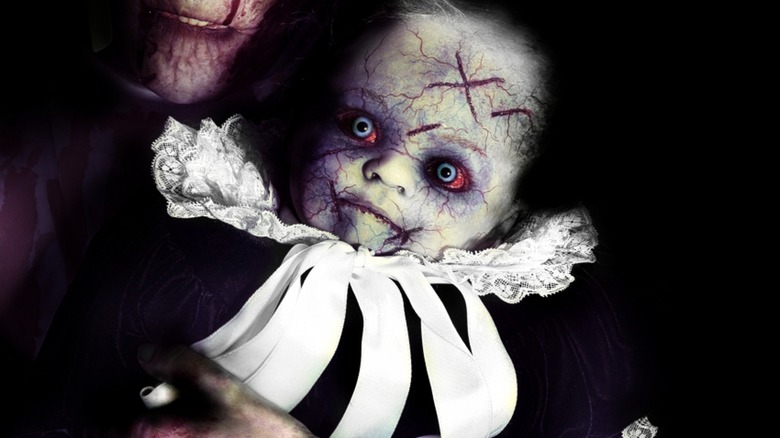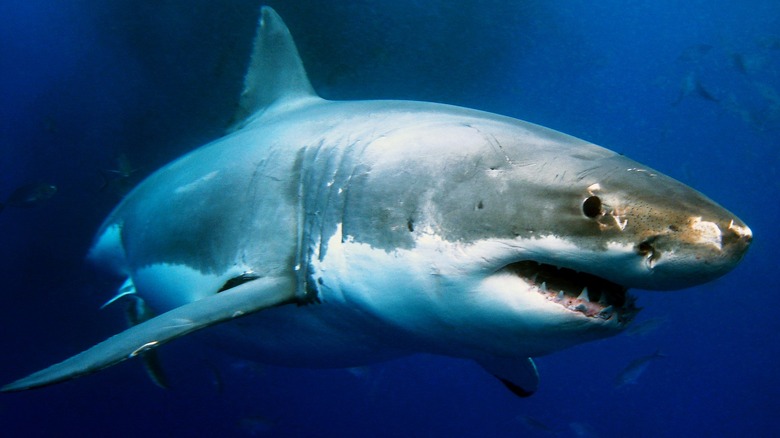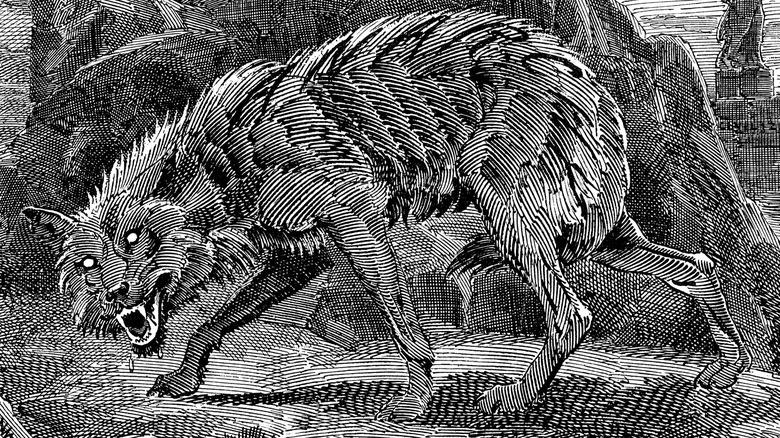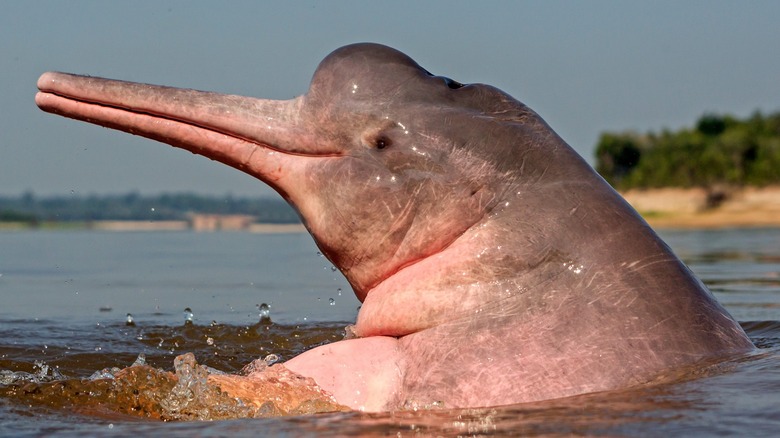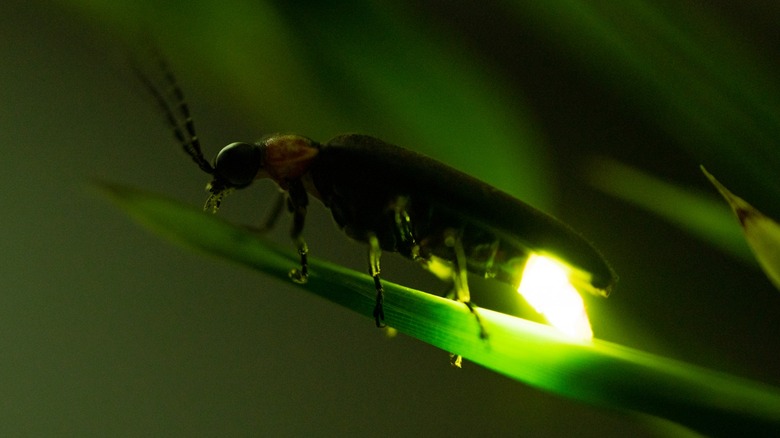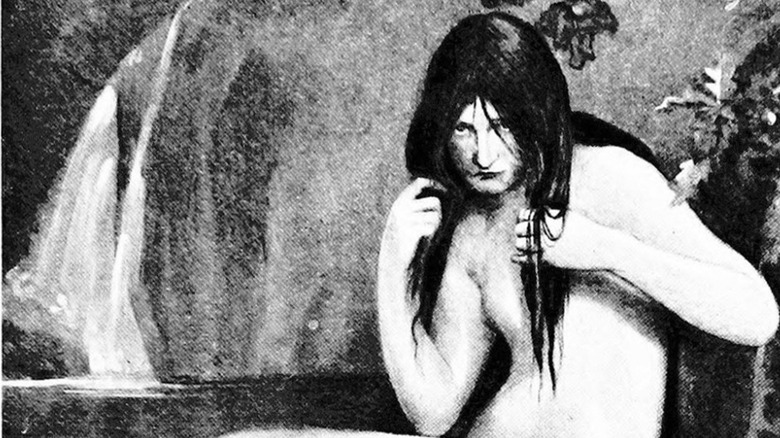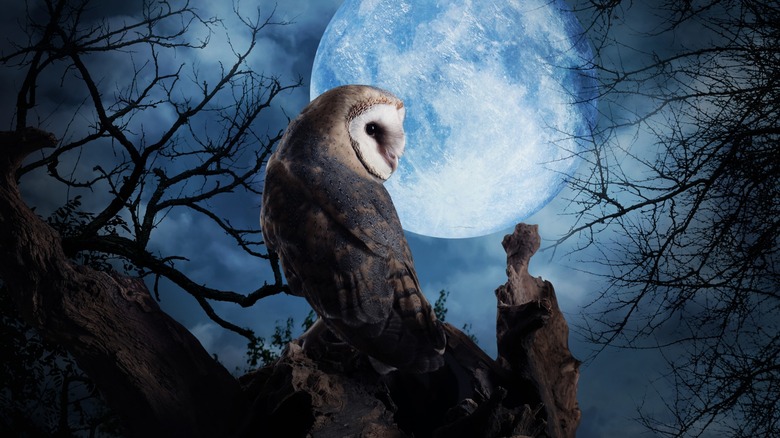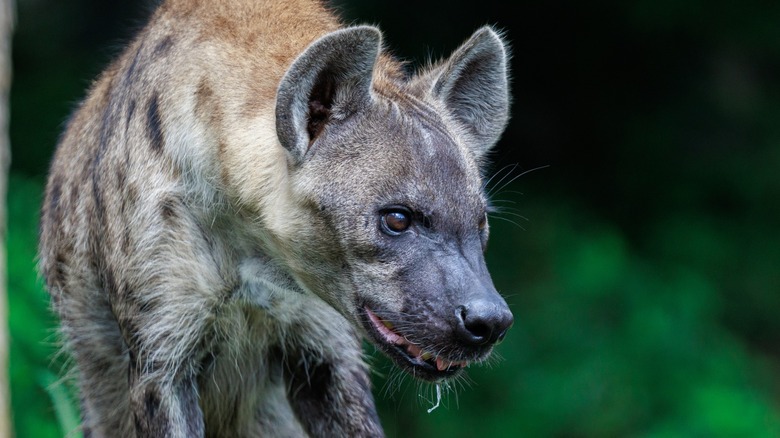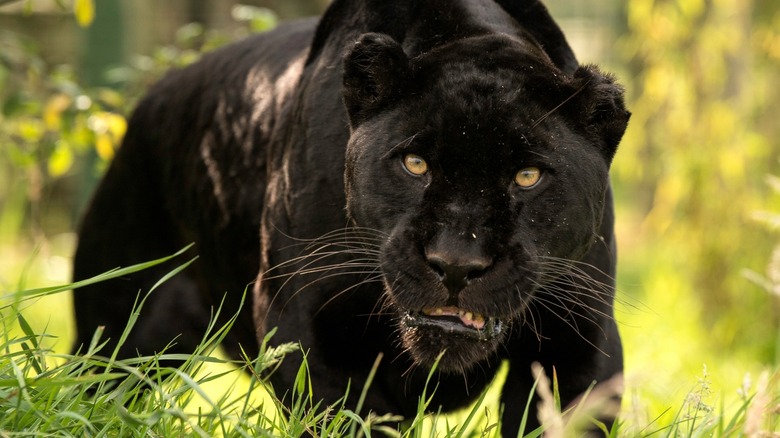14 Types Of Shapeshifters You Probably Haven't Heard Of
From terrifying werewolves to "X-Men's" Mystique to that dream where you were a dolphin, we humans are positively fascinated with the idea of shapeshifters. And why wouldn't we be? The ability to freely change forms would certainly come in handy — and would be pretty fun to boot. As a concept, shapeshifters blur the lines between animal and human, wild and tame, and fantasy and reality.
They allow the imagination to run free, unfettered from society's demands. But, while they might seem like a fairy tale trope or the invention of modern horror stories and science fiction movies, shapeshifters have actually been around a long time — and, depending on who you ask, they are very real. Spirits and beings that can change forms exist in the mythology and folklore of almost every culture and span the entire globe.
Yes, shapeshifters go far beyond conflicted werewolves and nefarious Marvel characters. As you might imagine, the intent of such creatures also varies widely, with some being benign and even celebrated while others are strictly out for blood and destruction. Here are 14 types of shapeshifters you probably haven't heard of.
Kushtaka
Sometimes, it's the creature you least expect that wields dangerous shapeshifting ability. The Indigenous Tlingit, Tsimshian, Nootka, and Haida people of northwestern Canada and Alaska believe in malevolent shapeshifting sea otters called kushtaka or kooshdakhaa that can turn into people or large two-legged half-otter, half-human creatures.
Kushtaka lure people into the forest or ocean to violently kill them using their sharp claws, trapping their souls, forbidding them from being reincarnated, and dooming them to wander Earth forever in limbo as a kushtaka themselves. They may travel alone or in a group and are said to communicate in a very specific series of whistles that alternate between low and high tones. They sometimes even take the form of a person's family member or wail like a sad child to entice them.
Luckily, kushtaka are allegedly deterred by dogs, fire, and large groups. Beware the deceptively adorable sea otter and seemingly helpful savior – especially when adrift in the water or lost in the woods — and watch out for bipedal otters or strange groups of people when traveling alone near the North Pacific Ocean. Once a kushtaka has locked onto you, there's no coming back.
Aswang
What's more terrifying than a werewolf, a witch, or a vampire? How about a creature that combines the worst aspects of all three. In the Philippines, tales of the fearsome night-prowling aswang have persisted since the 16th century. In fact, several were reported in the Visayas islands as recently as 2020. By day, the creature disguises itself as a regular person — typically a pretty woman with long, dark hair. It spends the daylight hours selecting an ideal victim, often a baby or child, then waits.
Once the sun goes down, aswangs change from a person into either a large bird, a human head and torso with wings and dangling entrails, or a Tasmanian devil-like beast. They then stalk their chosen victim, sometimes making clicking sounds or altering objects to confuse them, before brutally killing and devouring them. Like vampires, aswangs have a preference for blood, which they imbibe with their long proboscises, though they also enjoy the heart and liver.
These creatures are crafty and sometimes make a doppelgänger of their victims to fool others into thinking the death was natural. The aswang takes several forms and represents an entire category of shapeshifting monsters in Filipino folklore. In human form, they can be recognized by their bloodshot eyes, backward feet, and hatred of light. If you look one in the eyes, your reflection will be upside down. Aswangs can be repelled with salt, garlic, holy water, and snapping whips made of stingray tails (if you happen to have one).
[Featured image by H.M.Bec via Wikimedia Commons | Cropped and scaled | CC BY-SA 4.0]
Kitsune
Some shapeshifters are masters in the art of seduction. In Japanese folklore, kitsune are supernatural foxes that can turn into humans once they reach a certain age. They typically turn into attractive women, retaining some fox-like characteristics in their changed form, like close-set eyes and high cheekbones. These features are considered attractive in Japan, so, as you might expect, men often find kitsune women to be quite foxy.
Most kitsune are benevolent and some are even associated with Japanese deities. They gain wisdom and magical abilities as they age, and can live for several hundred years. Old kitsune can accrue up to nine tails in their fox form. Meanwhile, wilder kitsune are often mischievous or even vindictive and may possess women for the purpose of tricking and seducing men, stealing their life force, exacting revenge, or simply having fun. This doesn't usually end well for anyone involved.
A less sinister kitsune may also marry a man while in human form only to disappear mysteriously one day. It's said that if you see a woman walking alone at night, she could be a changed fox. Shadows and reflections will always give away their true form, and they are deterred by dogs and incense. Other similar fox shapeshifters include the Chinese huli jing, Korean kumiho, and the Japanese tanuki, which is essentially the male version of a kitsune that turns into a raccoon dog.
Selkie
In Irish, Scottish, and Icelandic folklore, selkies are seal shapeshifters that can shed their skins and tails and come ashore. They usually take the form of dark-haired humans who are often alluring and attractive to mortals. Selkies have pleasant, kind demeanors and frequently mingle with humans in coastal towns while ashore.
But, in order to return to the sea, they must put their skins back on. Should their pelts be lost or stolen, they will remain trapped in human form forever. In many tales, selkies are females whose skins were stolen by men while they slept. Unable to change back into seals, they were tricked into marriage. But, even after long lives spent raising families, they continue to long for the sea. Sometimes, they rediscover their stolen and hidden skins years later.
Once a selkie touches their skin, they are compelled to put it on and return to the sea. They may abandon their families or take their children with them, which doesn't always end well. Though far less common in lore, male selkies also exist — and are just as irresistible. They may seek out and form connections with sad human women and can be summoned at any time when she cries seven tears into the sea.
Bakeneko
Beware the malevolent shapeshifter already living in your home. In Japanese folklore, the bakeneko is an ordinary house cat that attains supernatural abilities if certain criteria are met. For one, it must be at least 13 years old. It also must have a long tail and weigh over 7 pounds. Such a "changed cat" is then able to shapeshift into a person and walk on two legs, effectively taking control of its owner and household. Once changed, bakenekos can do all sorts of things.
They can raise the dead, make their owners dance against their will, feast on corpses, hurl fireballs, possess people, and even turn into full-blown vampires. As you might imagine, they can wreak some serious havoc. If a bakeneko has a tail that has split into two, chaos, destruction, and even death is guaranteed. In fact, many Japanese people used to cut the tails off their cats to ensure that such a powerful demonic feline never arose. In less severe cases, bakenekos simply turn into humans and enjoy a night out on the town before returning home.
Tiyanak
Shapeshifting can be an effective tool for evil entities seeking easy access to victims. In Filipino folklore, a creature called the tiyanak dwells in Philippine forests and takes the form of a helpless crying baby or wailing toddler to lure victims. It can even mimic individual voices to tempt people deeper into the woods. The tiyanak is a master at auditory deception and may vocalize loudly when it's far away and more faintly when it's actually quite close.
In Tagalog, "tiyanak" roughly translates to "baby vampire." As the name suggests, they initially look like normal human babies or children lost in the woods. But, once gently cradled, it quickly transforms into a horrific fanged vampire baby with bulging eyes and slashing claws and devours its savior. In some versions of the legend, the tiyanak is a disabled monster that has to resort to trickery to capture prey.
In others, it floats or flies. Most believe tiyanaks arose due to guilt surrounding abandoned babies or, more disturbingly, as the spirits of babies born in the grave after their mother died during pregnancy. Either way, if you ever find yourself in the clutches of a tiyanak, strip down and put your clothes back on inside out, as it's said that this will confuse and amuse them long enough to break their spell and release you. It can't hurt to try!
Shark aumākua
In Indigenous Hawaiian folklore, revered family gods often take the form of certain animals, plants, or other natural elements like volcanoes. They can also change themselves into humans at will. According to Emma M. Nakuina and others in "Nanaue the Shark Man and Other Hawaiian Shark Stories," these entities, called aumākua, can be benevolent or malevolent depending on the situation.
While there are quite a few such spirits, shark aumākua are especially prominent in Hawaiian lore either as supernatural shapeshifting sharks or shark-human hybrids. They are also capable of interbreeding with humans. In one of the most common legends, a boy named Nanaue was born to a shark father and a human mother, which gave him a shark's mouth on his back and the ability to change into a shark whenever he entered the sea. His mother was warned not to feed him meat, as he would develop an insatiable appetite. She did not heed the advice.
Nanaue worked as a farmer, hiding his shark mouth and abilities. But, having a strong desire for flesh, he would occasionally transform into a shark to feed on swimmers. He would find his victims while human and follow them to the water. Eventually, he was discovered and burned alive. Another shark shapeshifter, Hika-welo-ula, also had a shark father and a human mother. He lived as a man but took the form of a red shark at sea, as he had been swaddled with red cloth as a baby.
Skinwalker
In the lore of Navajo, Apache, Hopi, Pueblo, and several other Indigenous nations of the American Southwest, skinwalkers are powerful witches, medicine men, and sorcerers who have become evil, using their magic to commit murder and other nefarious acts. Unlike other humans granted the ability to shapeshift — namely werewolves — skinwalkers are in complete control while transformed.
Able to take the form of or possess whatever animal is convenient, but having a preference for wolves and bears, they terrorize anyone who crosses their path and are known to chase cars or tap on the windows and doors of dwellings. Skinwalkers typically walk on four legs but sometimes retain somewhat human facial features. They are also practically invincible. Many Navajo people refuse to speak about them for fear of summoning one.
Because of this, most of the world was blissfully unaware of their existence until 1987, when a skinwalker was blamed for the death of a woman in Arizona. Another notable encounter occurred in Utah at what is now known as Skinwalker Ranch in 1996. A man claimed he was walking his dogs at night when he was accosted by a giant wolf with glowing red eyes. He shot the creature three times, but it was impervious to bullets.
Boto encantado
Amazon pink river dolphins have always intrigued us. Perhaps it's their pale skin and smirking expressions. Or maybe it's their large size and tremendous intelligence. Either way, there's something almost human about them — and Brazilian folklore offers one possible explanation for this. The pink river dolphin, also called the boto, is believed to be able to take human form and come on land on nights when the moon is full.
Specifically, these boto encantados take the form of attractive men in white suits who wear hats to hide their blowholes. Sometimes, they appear more like mermen, being half-human and half-dolphin. Once on land, they seduce women and often impregnate them before returning to the murky water and disappearing into the depths. In Portuguese, "boto encantado" translates to "enchanted dolphin."
Children born of such an encounter — or out of wedlock in general — are still referred to as "children of the boto." Some people believe that the seductive dolphin men merely hide the real story: rampant sexual abuse of women in the Brazilian Amazon. Others have made the connection between the botos' white-colored outfit of choice and the violent conquest of Indigenous Brazilian people by white men in the 1500s.
Adze
Most shapeshifters take the form of large, powerful creatures for obvious reasons. But being very small has its own advantages. In West Africa, the Indigenous Ewe people believe that malevolent witches called adzes can take the form of flies, beetles, fireflies, mosquitoes, owls, and even balls of light and enter dwellings through small openings such as keyholes at night. Once inside, they feed on the blood of whoever is within, having a special preference for beautiful children.
Adze bites can cause intense suffering, possession, insanity, or death. Anyone can be possessed by an adze, but it happens more commonly to women. Possession can cause all manner of issues, including addiction, mental illness, intense jealousy, and even relationship problems. While possessed, a person exudes balls of light that turn into flying insects at night. These then travel great distances and infect others. And you thought mosquito bites were bad!
Adzes can be exorcised, though it's an extremely difficult process that involves expelling it from its host and clubbing it while it's in a transitional form: a black, hunched humanoid creature with talons. Prayer might also help, and adzes in their insect form may accept palm oil in place of blood. Historians believe that the adze is a physical representation of the fear that then-incurable insect-borne diseases like malaria caused. Over time, this fear merged with the concept of the Christian devil and the adze lives on into the modern age.
Kelpie
While some shapeshifters present shades of gray when it comes to intent, kelpies are strictly malevolent. These Scottish water spirits typically transform into a horse, pony, cow, or beautiful woman — whichever form they think will be most enticing. They hang out at lakes, rivers, lochs, and other bodies of water at dusk and attempt to lure children, men, and other travelers into the water to drown and eat them. (They especially love livers.)
Kelpies often wail or moan and may make a loud thunderous sound by slapping the water with their tails. They can also summon spontaneous floods. And be extra wary of a stately horse or gentle pony standing in the water. Oftentimes, these creatures will have seaweed entangled in their manes and tails and backward-facing hooves upon closer inspection — but by then it will probably be too late.
Once mounted on such a water horse, a person becomes trapped by a magical sticky substance and unable to escape. The steed then plunges them into the deep water to their death. Humans usually lose in a match with a kelpie, but, should a person somehow manage to grab the bridle of one in horse form, they may conquer it — and any other kelpie they encounter.
Stikini
Stikini are terrifying owl shapeshifters of Indigenous Seminole folklore that take human form by day but turn into giant human-owl hybrids against their will at night following a painful and grotesque transformation, similar to that undertaken by werewolves. They then fly through the forests of the American South and hunt sleeping people – especially children – in their beds, much like vampires.
Though they don't have much choice in the matter, it's hard to pity a creature that routinely feasts on the still-beating hearts of children. Like skinwalkers, stikini began as evil witches who gained power by committing vile acts. In human form, they often look normal but act strange and aloof. Each night, they travel deep into the forest to avoid being seen and vomit up their souls and internal organs, which they hang high in the trees for safekeeping.
Then, they take to the skies as a giant humanoid owl hungry for human flesh. Stikini are said to issue a blood-curdling scream that serves as an omen of death, which is all but certain if one catches up to you. Stealing a stikini's organs is the most effective way to defeat one, as it will then be unable to return to its human form and will burn to death in the sunlight.
Werehyenas
Werewolves might be the most famous shapeshifter, but there are plenty of other werebeasts out there. In the folklore of Somalia, Ethiopia, Sudan, and other Indigenous people living near the Horn of Africa, the qori ismaris or bouda is a dangerous werehyena that stalks towns at night. People still rush to get indoors as the sun sets, making sure no one is left outside when darkness falls.
Werehyenas typically transform from human to animal at night, then return to their human forms at dawn. But, unlike werewolves, they can change at will using magic rituals, ash, and special sticks. They may be born human but turned into a werehyena, or they may be a wild hyena capable of transforming into a human. As a result, any person or hyena should be viewed with suspicion. Strangers and village blacksmiths, especially, are likely to be shapeshifting hyenas.
With their laughing vocalizations and penchant for opportunistic hunting and scavenging, hyenas have long been feared by African people. For some, the idea of an evil werehyena lurking around the village at night, snatching errant children and picking off wandering couples, isn't that far-fetched.
Nagual
In parts of Central America and Mexico, many Indigenous people believe that a totemic guardian or spirit animal is assigned to each person in their life. This creature typically presents itself to a person through a dream. On some occasions, powerful men such as sorcerers can even change into their animal and conduct evil — though not all such shapeshifters, called naguals, are inherently bad. Only certain people are lucky enough to be born naguals.
Jaguars, cougars, deer, birds, and wolves are all common animal forms for these shapeshifters. Sometimes, a person merely adopts parts of their nagual, like a beautiful singing voice if theirs is a bird. But, when this shapeshifting ability coincides with a strong animal totem, a mastery of magic, and evil intent, a nagual can become quite terrifying. Meeting a malevolent werejaguar with the sentience of a human on a dark night would surely chill the marrow of the bravest person.
